Container Gardening in the North
It doesn’t have to cost a lot for container gardening. It’s a good solution for growing food in the city and to offset rising food costs. Here are some pointers to get you started growing food anywhere.

Try container gardening
Container gardening in the city or on small suburban lots is one solution to the problem of rising food costs and the need for access to fresh food in the food desert of most cities. But the further North you go, the harder it is to actually be successful on a small lot or on the balcony of an apartment.
To successfully grow food in containers you need to provide:
- Light
- Organic fertilizer or soil nutrients
- A plant that can grow well in a confined space, and grows well with competition
- Adequate water and soil moisture
- The optimum temperature for germination and growth
Leave out one of these aspects and you won’t get a harvest. Have these five aspects in the right proportion and you may get several harvests from a single pot.
Let’s talk about what to do if you have a limitation in one of these facets. How do you solve the problem of limitations on the ideal growing conditions in organic gardening?
The Light problem
All vegetables do best in full sun. Some greens like lettuce don’t like the heat of the noon sun and can handle a bit of shading for part of the day, but no vegetable actually grows well without at least 6 hours of direct sun each day.
Plants use the full spectrum light, provided by the sun, to grow – called photosynthesis. The sunlight is converted in the plant’s cells into vitamins and other things required for growth. When sunlight is lacking, plants grow tall and spindly. Some plants rely on sunlight to produce flowers and will not flower in the shade. Plants that are required to flower before they will produce their fruit, your food, will not do well in shaded areas.
Some folks have solved this problem by growing their garden in containers on the south side of their house. Keeping your plants in containers means that you are less likely to come into conflict with the city planners, as some folks have done by moving their in-ground garden to their front yard. Others have solved it by moving their container garden around their yard as the sun moves. (Ok, I know that the sun doesn’t actually move but we are talking about gardening, not astronomy.) That’s a lot of work.
And if you have a really small piece of property or live in a townhouse or apartment you are more limited in where you can move the planters to. So if you live in a spot where one of these solutions will work for you, just skip to the next section. If you get no direct sun in your yard or on your balcony keep reading.
Using mirrors to increase the light to your plants
Depending on your situation, placing a mirror in a spot that will reflect some of the light that is coming to your balcony will increase the light that actually reaches your plants. Don’t do this if the mirror will get direct sunlight, as doing this could start a fire. But if you have a North facing apartment, placing a large mirror to reflect light onto your plants from the Northern sky will effectively increase the amount of full spectrum light coming to your plants.
You can increase the light getting to a specific plant by simply laying a mirror on the ground beside the plant and angling it toward the plant with a rock or a piece of wood. In a larger container, place the mirror on the soil surface, in the pot. You can use cheap dollar store mirrors for this.
If you have a small yard, with dark corners, try using a larger mirror flat on the ground and place your containers around it, so that it looks like a pond feature. This will effectively brighten up a dark corner, increasing the light that reaches the plants.
Grow lights
There are several varieties of grow lights on the market – even some new technology in LED lighting that provides the correct spectrum of light for the differing needs of plants at various points in the growing cycle. NASA is researching LED lights for extraterrestrial colonization – so this cutting edge technology. LED lights contain both Red and Blue spectrum lighting that meets the specific needs of plants at various stages of growth.
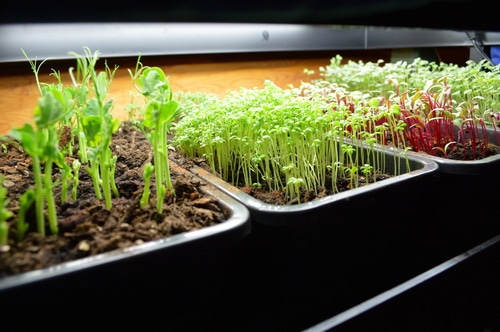
Most grow lights are full spectrum compact florescent lights that give plants the spectrum of light that they need for optimum growth. They are cool to the touch and so won’t overheat the plants. They are very efficient in their utilization of electricity. However, they need to be placed close to the plants in order to be effective. The lights should be placed – between 4 inches and 24 inches away from the top of the plants. The closer the light is to the plants the better the plants will grow.
Many folks use grow lights early in the season before the sun is fully in the Northern hemisphere, using daylight in mid and late summer.
If you have a south facing balcony you won’t need grow lights after May 1st, but depending on how far north you are, you may need them before then to provide adequate light to your plants.
There are other full spectrum fluorescent lights on the market that aren’t advertised as “grow lights”. These work, too, to provide the range of light (radiation) that your plants need to grow. Look for “full spectrum” or “daylight” on the label. They are a bit pricier than regular compact fluorescent bulbs but have a long lifespan and are fuel-efficient.
Organic fertilizer and soil nutrients
The best potting soil for your container garden is organic potting soil with an organic fertilizer in the soil mix. Plain potting soil may be adequate for getting your seeds started, but without adequate fertilizer plant growth will be stunted. Many growers who aim at organic growing will use chemical fertilizer to get the seedlings off to a strong start. But there are alternatives to chemical fertilizers.
Worm bins will turn your kitchen waste into a fertile soil amendment that can be added to your garden containers. The science of breeding red wigglers in your kitchen is for another article. Here I’ll just mention that worm-castings (poop) is the best medium for transplanting your seedlings into after the first true leaves have emerged.
If you have a small yard and access to weeds and grass clippings you can create compost that can be added to your pots to increase soil fertility and give plants the minerals that they need to grow well. Adding fish fertilizer, kelp meal, or liquid manure tea to plants during the growing season is also helpful. Many garden stores sell manure tea bags that you can steep and cool to water your container gardens with. It’s a bit more expensive than making your own manure tea, but it has been sterilized and deodorized.
DIY manure tea:
Visit a rabbit farm, goat, sheep, or llama/alpaca farm in the spring and ask for a pint of fresh berries. Put it in a 1 gallon pail with a tight fitting lid. If you can get some comfrey, nettles, or some kelp, cut these plants into small piece and add to the bucket. Use gloves to handle the nettles. Cover with non-chlorinated water and let it steep on your balcony for 2 weeks. Strain and use the liquid on your plants. Add more liquid to replace what you used. It will become weaker and will need to be refreshed after a couple of regenerations. Keep tightly covered when not in use – it is strong! Do not bring it inside your home.
Choosing plants that grow well in containers
Salad greens, spinach, and smaller versions of some garden plants will all grow well in containers. Vining plants that are labelled “determinant” have a controlled growth habit and will grow well in a container garden, too.
If you have a Northern garden, you will want shorter season varieties of some of the time-needy plants like tomatoes, cucumbers, peppers, and squash, to get an adequate harvest. Consider providing a trellis for climbing plants and you will be able to grow more food in a smaller space. Cucumbers and cherry tomatoes both grow well in containers; provided that you give them a place to climb that will expose their leaves to lots of light.
Adequate water and soil moisture
You will want to keep your plants from drying out during the growing season. When a plant dries out you will delay flowering by up to two weeks. In a Northern season, this could mean the difference between getting green leaves and actually getting something to eat.
You can increase the retention of water in the soil by adding mulch to the soil surface, putting something that retains soil moisture inside the root zone, or by adding some form of automatic watering system to keep the plants moist.
Since I am filling my spring pots around the same time as spring shearing, I will put some of the wool dags from the fleece (the parts of the fleece that are caked with mud and urine) into the bottom ¼ of the pot before filling with soil and finished compost. The fleece helps to maintain soil moisture and gives off nitrogen as it breaks down in the pot, increasing soil fertility. You want to avoid adding anything to the bottom of the pots that ants or flies may perceive as a food source – so no uncomposted food.
Using gray water to water your container garden
Grey water or rainwater can be used to water your plants. If you want to try this and don’t have an automated way of saving and pressurizing the gray water, consider installing a barrel on your balcony with a tight fitting lid and a strainer at the outflow. Do your dishes in a washbasin, inserted in your kitchen sink, and carry the washing-up water, in the basin, to your barrel each evening and dump it in. To keep the water organic, use only natural organic soap, like Dr. Bonner’s liquid castile soap, in your washing-up/dishwater. You won’t want to use washing up water that you’ve added chemical dish soap if you are growing organically.
The optimum temperature for growth
A plant’s temperature needs vary depending on where it is in its growth cycle and also on what kind of plant it is. Give it the wrong temperature at the wrong time and you could end up tricking the plant into behaving as if it’s gone through the winter and is living in its second spring – seed setting time. We call this “bolting” and it’s enough to make you cry, as all your efforts are wasted on a bolting plant.
Beets, chard, radishes, and bok choy all respond to a suddenly cool night by bolting – sending up its seed stock and stopping its growth of root and leaf. You want to avoid this by planting bolt-resistant varieties, and by making sure that your container plants have the correct temperatures for the right growth. Other plants, like peppers, need adequately warm temperatures to grow and produce fruit. Heat can be simulated in Northern climates by adding heat sinks to your garden area. Black bottles filled with water, rocks on top of the soil in the pots, or masonry act as heat sinks, absorbing heat from the sun during the day and giving it off at night, as the temperature drops. You can increase the amount of heat absorbed by painting rocks or masonry a dark, non-glossy colour.
In early spring, you can add adequate soil warmth by putting your seedling trays on top of your fridge or in a warm place, near a woodstove (but not too warm). Check your seed catalogue for optimum germination temperatures for each species of plant that you are planting.
Here’s the recap:
To be successful in growing in containers you need to provide 4 main essentials for optimal growth
- Light
- Soil nutrients
- Water
- Temperature
How you provide these essentials is up to your creativity and resources. And finally, use a plant variety that grows well in a container. (More ideas about that in another post. )
It doesn’t have to cost a lot to grow in containers, as many household items can be up-cycled to meet the need of a container garden.
Plants that you can grow in containers:
New to growing microgreens?
Check out the Fill Your Salad Bowl workshop and learn how to use 3 different growing methods, at home, so you can fill your salad bowl with super food, nutrient dense, greens every single day. These are greens you can use in your salad bowl, greens you can add to soups, stews, and pasta dishes, and even greens you can use in a stir fry.
In this mini workshop you will learn how to fill a salad bowl every day with food you grow yourself.
- Even if you don’t have any land.
- Even if there is 3 feet of snow covering your garden
- Even if you’ve killed house plants in the past.
- Even if you think you have a black thumb.
Have a look at what’s covered in this workshop and see if it’s a good fit for you, by clicking/tapping the blue button below.


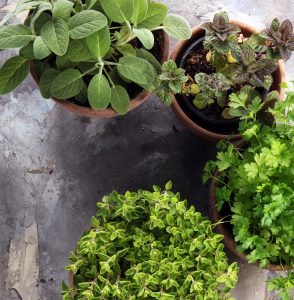
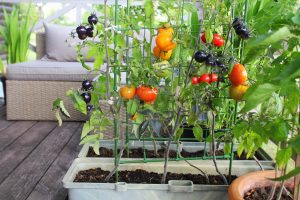
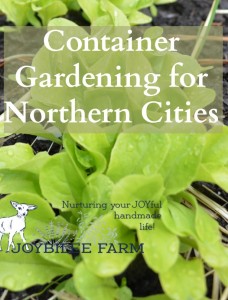
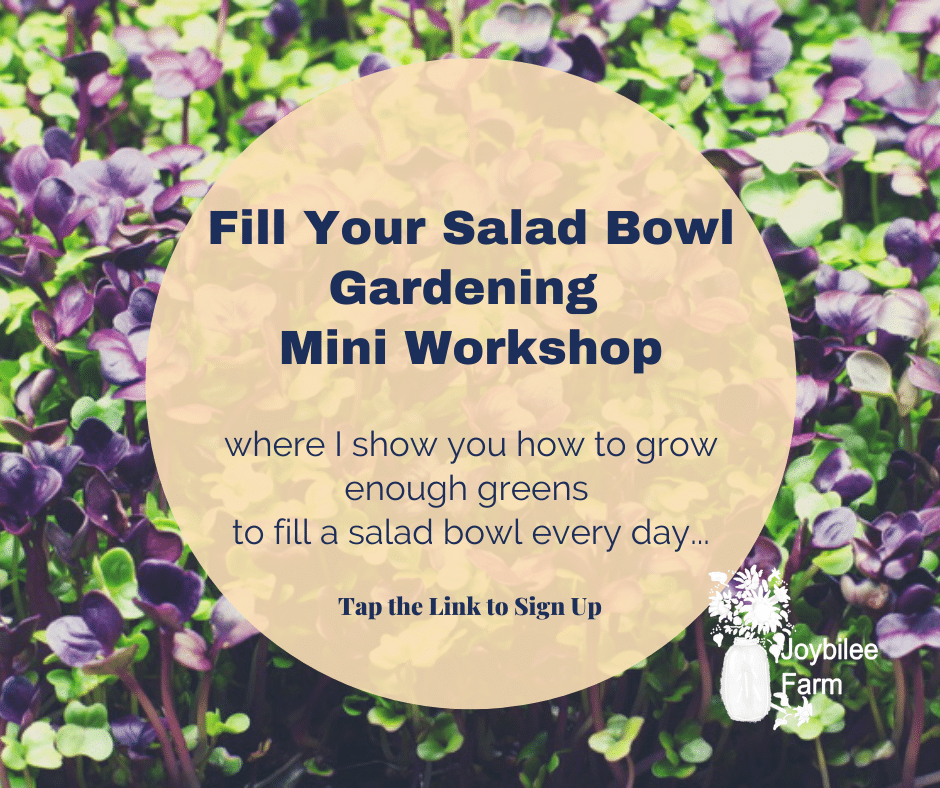


How often do you add mulch to the soil surface in a year?
I all just added my compost to any soils I get what do u think about adding green and food scrap to bed garden at the bottom before potting soil and compost in bed what do you think